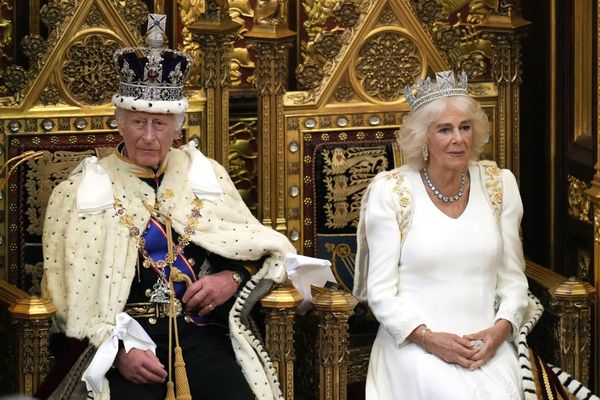The Australian share market has recouped some lost ground after yesterday's $60 billion sell-off as calm returned to Wall Street and as employers hired more people last month.
The Bureau of Statistics said the national jobless rate rose 0.1 percentage point to 3.5 percent in August from 3.4 percent in July, on a seasonally adjusted basis, as more people returned to the workforce.
Employers hired nearly 34,000 people over the month, reversing a fall in July.
Capital Economics said the first rise in Australia's unemployment in 10 months may prompt the Reserve Bank to slow the pace of rate increases to a 0.25 percentage point rise next month, instead of half a percentage point.
However, Nomura's Andrew Ticehurst is still predicting a 0.50 percentage point hike by the RBA in October.
ANZ economist Catherine Birch told ABC News that she also agreed that a half a percentage point rise was more likely next month.
"We think the solid labour market result today, the strong NAB business survey, and US CPI data early this week, all add to the case for the RBA to lift the cash rate by 50 basis points in October," she said.
Over lunchtime, the market rose by 0.7 per cent after employment figures came out.
However, it gave up those gains by the close.
The All Ordinaries index gained 0.15 per cent to 7,083, while the ASX 200 index rose 0.2 per cent to 6,843 with just energy stocks and banks ending higher.
The market fell nearly 3 per cent yesterday, the largest percentage fall in three months.
Wall Street saw its biggest losses since 2020 on Tuesday after consumer prices rose in North America last month sparking fears of more steep interest rate rises.
Westpac closes branches
Westpac plans to close another 24 bank branches with 103 jobs to go, and the Commonwealth Bank is closing three more branches to save money as customers do more online banking.
The Westpac move follows the closure of 48 branches in August and July.
The latest closures include Westpac, Bank of Melbourne, and St George branches in New South Wales, Queensland, Victoria, South Australia and Western Australia.
Finance Sector Union national secretary Julia Angrisano said the cuts would affect tens of thousands of Westpac customers.
"It is clear Westpac has no regard for the community across Australia after shutting down 225 branches since January 2021," she said.
A Westpac spokesperson said customers would be assisted to do their banking via phone, online, and at Australia Post.
"Declining customer use of branches means that in some instances, we may take a difficult decision to leave a branch location."
"We have a robust process in place to assist employees to find new opportunities within the Westpac Group, meaning the majority of employees affected secure a new role."
Westpac shares rose 1.7 per cent.
The Commonwealth Bank is closing branches in Tenterfield and Junee in New South Wales, and Reynella in South Australia.
Movers and shakers
Most industry sectors fell on the ASX with miners, education firms, real estate and consumer stocks among the losers.
The best performers on the ASX 200 index were coal firms Coronado Global Resources (+9.1 per cent), New Hope (+6 per cent), and Whitehaven Coal (+4.6 per cent).
Going down were lithium firm Lake Resources (-12.7per cent), and miner South 32 (-7.4 per cent) as it traded ex-dividend,
The Australian dollar jumped after the employment data came out but then slipped back to around 67.55 US cents.
Myer profit
Retailer Myer said its annual net profit rose nearly 6 per cent over the year to $49 million, helped by strong sales growth at both stores and online.
Sales rose 12.5 per cent over the year to nearly $3 billion.
Myer chief executive John King said it was the best profit result for the second half of the financial year for the company in a decade.
"Despite the broader economic uncertainty, we are well placed with the right value based proposition of affordable and aspirational brands," he said.
Investors get a fully franked final dividend of 2.5 cents a share.
Myer shares recovered ground to end steady at $0.64.
Mosiac Brands fined again
Retailer Mosiac Brands has been fined $266,400 for making misleading claims about government approval of products.
The consumer watchdog said the fashion retailer made the claims while promoting a KN95 face mask on its Autograph Fashion brand website and a hot water bottle on its Katies brand website.
The Australian Competition and Consumer Commission said Mosiac Brands falsely represented the mask as being approved by US and European regulators, and said the hot water bottle was ACCC approved when it was not.
"We were very concerned about the type of representations being made by Mosaic Brands," ACCC Commissioner Liza Carver said.
"These penalties are a warning to all businesses that making false or misleading representations about government approval for their products can lead to ACCC enforcement action, with serious consequences including penalties," Ms Carver said.
Mosiac Brands was fined more than $600,000 in 2021 after it admitting making false or misleading claims about hand sanitiser and face masks during the COVID-19 pandemic.
Its shares were steady at $0.28.
Canadian software firm Dye and Durham has got the go-ahead from the Foreign Investment Review Board to take over share registry Link Administration.
However, investment house Morningstar said Link's buyout was unlikely given the regulatory issues it faces in the UK.
Link's shares fell 0.9 per cent to $3.50.
Tyro Payments (-3.8 per cent) appointed insider Jonathan Davey as its new chief executive to replace outgoing boss Robbie Cooke, who will lead disgraced casino group, Star Entertainment.
Wall Street recovers ground
Bargain-hunting investors moved in to buy the dip after Tuesday's battering which saw Wall Street post its worst losses since the height of the coronavirus pandemic in 2020.
All three major Wall Street indices had a volatile session but ended higher.
"Today is a lick-your-wounds day, after taking body blows yesterday," said Ryan Detrick, chief market strategist at Carson Group in the US.
"The inflation debate continues and yesterday was a harsh reminder that this is a tough battle and the Fed needs to remain aggressive to put a lid on widespread inflationary prices we're seeing."
Energy stocks did the best on the Dow Jones Industrial Average after an overnight rise in oil prices.
By the close, the Dow Jones index rose 0.1 per cent to 31,135, the S&P 500 put on 0.3 per cent and the Nasdaq Composite rose 0.7 per cent to 11,720.
US wholesale prices down
US producer prices fell for the second month in a row in August as the cost of gasoline declined further and the price of goods fell.
The producer price index for final demand fell 0.1 per cent last month, after falling by 0.4 per cent in July.
That is the first back-to-back drop since 2020.
However, core inflation, which removes volatile items like prices of food and energy, rose 0.4 per cent over the month, up from 0.2 per cent in July.
The cost of services increased by 0.4 per cent in August, mainly because of higher margins received by wholesalers and retailers and a shortage of workers.
Over the year, the PPI rose 8.7 per cent, down from a 9.8 per cent increase in July.
"Most likely retail goods prices will at least soften somewhat in line with PPI and that should keep Fed officials breathing a small sigh of relief after the still-high, but not unexpectedly strong PPI reading," said Andrew Hollenhorst, US chief economist at Citigroup.
ANZ economists said the PPI figures "did nothing to allay fears that the Fed will need to hike considerably further if it is to meet its inflation mandate."
The market expects the US central bank to raise official interest rates next week by 0.75 per cent.
UK inflation eases
While consumer inflation rose in the US in August, retail prices in the United Kingdom eased back over the year to 9.9 per cent, from a 40-year high of 10.1 per cent in July, because of a fall in petrol prices.
However, core inflation, which strips out volatile food and energy prices, lifted, with food prices going up for the 13th month in a row.
US inflation stood at 8.3 per cent over the year, still lower than in the UK.
European stocks fell on the back of the rise in consumer prices in the US and fears of steeper increases in interest rates.
In London, the FTSE 100 index fell by 1.5 per cent to 7,277, the DAX in Germany lost 1.2 per cent to 13,028, and the CAC 40 in Paris fell 0.4 per cent to 6,222.
The International Energy Agency said global demand for oil is expected to come to a standstill later in the year as the global economic slowdown deepens.
However, the agency thinks fuel demand will rebound next year.
Oil prices rose after US inventories fell to the lowest level since 1984 and amid threats of railway strikes in the US.
The Biden administration is considering refilling its strategic oil reserve if West Texas crude falls below $US80 a barrel.
Brent crude increased 1.5 per cent to $US94.52 a barrel, while spot gold fell 0.3 per cent to $US1695.74 an ounce.
ABC/Reuters







